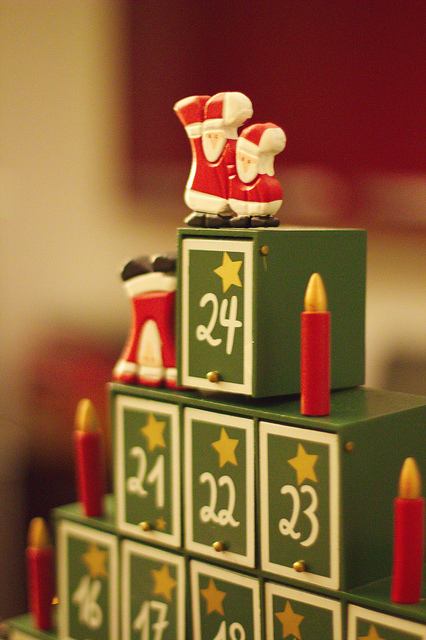Calendrier de l’Avent – Waiting For Christmas In French Posted by John Bauer on Dec 13, 2017 in Culture
When I was growing up I loved waking up every morning and being able to open a new door on le calandrier de l’Avent (the Advent Calendar). The gifts inside was never anything special, but they definitely added to l’esprit des fêtes (the holiday spirit).
C’est bientôt Noël (it’s Christmas soon), and that means that the air is filled with more than just cold weather. Les marchés de Noël are popping up all over France and Christmas music like Au Royaume du Bonhomme Hiver et Bonjour Noël are being played everywhere.
L’esprit des fêtes with all the holiday music and le vin chaud always makes me feel nostalgique (nostalgic). So when I saw une pub (an ad) for un calendrier de l’Avent, I was happy to see the fun holiday tradition exists en France!
La publicité (the advertisement) made me curious and I decided to look up l’histoire du calendrier de l’Avent (the history of the Advent calendar) to find out the origin of the tradition.
Le calendrier de l’Avent started in the 19th century en Allemagne (in Germany). The idea began with people giving des petits cadeaux (little gifts) to children during the weeks before Christmas and slowly evolved into the form of un calendrier over the course of le 19e siècle.
Outside of l’Alsace, it wasn’t until the 1990s that le calendrier de l’Avent took root en France, but they quickly became popular and were soon a common fixture at les marchés de Noël.
Mais qu’est-ce que c’est l’Avent ?
But what is the Advent?
L’Avent is connected to various Christian churches and generally refers to a period of several weeks before Noël (Christmas). The term originally comes from the Latin word for arriver (to arrive, to come), alluding to l’avènement de Jésus-Christ (the coming of Jesus Christ).
Advenire → Adventus → Advent → Avent
En français, l’orthographe (the spelling) advent was used into the 14th Century before the modern orthographe of avent became standard.
Traditionally, le nombre de jours de l’Avent (the number of days of the Advent) can vary slightly depending on the year. Christmas is always on le 25 décembre, but l’Avent starts 4 Sundays before the holiday. This confusing way of counting leads to la periode de l’Avent (the period of the Advent) varying slightly depending on which day of the week Noël is on.
Ajourd’hui (today) most calendriers de l’Avent that you find at les marchés de Noël simplify things by always starting on le 1 décembre.
The fun thing about le calendrier de l’Avent is how les cadeaux can be anything you want. Growing up most of les calendriers that I had were hiding small pieces of chocolat, but a good way to practice French over the holidays could be to make un calendrier de l’Avent that hides un mot du jour (a word of the day)!

Build vocabulary, practice pronunciation, and more with Transparent Language Online. Available anytime, anywhere, on any device.




